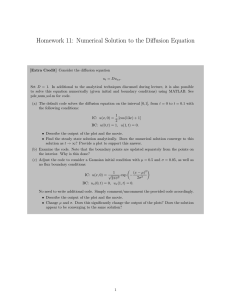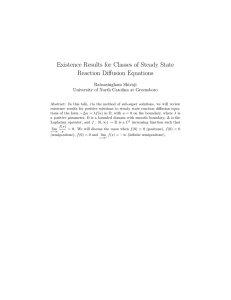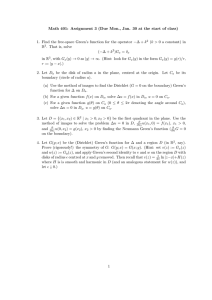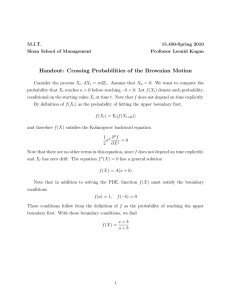1.061 / 1.61 Transport Processes in the Environment MIT OpenCourseWare .
advertisement
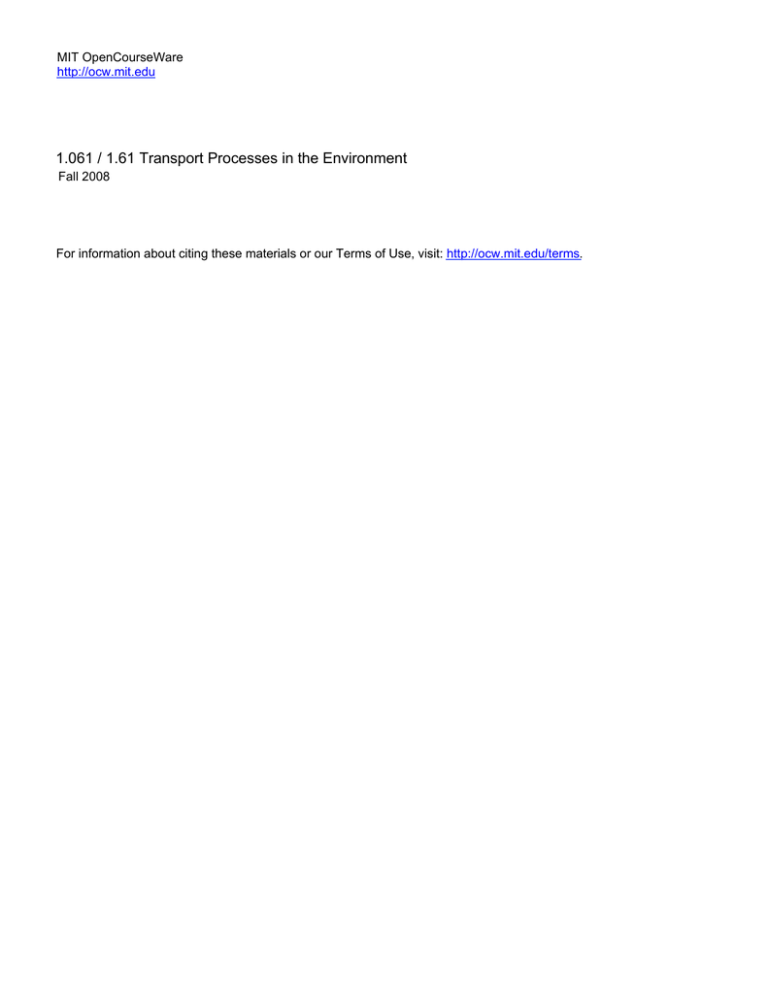
MIT OpenCourseWare http://ocw.mit.edu 1.061 / 1.61 Transport Processes in the Environment Fall 2008 For information about citing these materials or our Terms of Use, visit: http://ocw.mit.edu/terms. Problem 4.1 A slug of mass, M, is released instantaneously into the corner of a large, shallow box. The full width and length of the box are LX = LY = 100L, and the height of the box is LZ = 0.01L. Every wall of the box is a no-flux boundary. The mass is released a distance L from two adjacent walls, and mid-way between the top and bottom boundary. Assume isotropic diffusion within the box, represented by diffusivity, D. 2 Describe the concentration field inside the box from t = 0 to t = L /D. Hint 1 When will the mass be mixed uniformly in the vertical? Hint 2 Estimate when the mass will reach each vertical wall in the box Hint 3 How will each boundary impact the solution in the time t = 0 to L^2/D ? Hint 4 Place image sources to satisfy the no-flux boundary condition Problem 4.2 You own a house and dock along a boat canal, which ends 25 m upstream from you. One day, your neighbor has a small (1 kg) fuel spill. Due to the boat traffic, the diffusivity in the canal is quite high, D = 0.01 m2/s. The current in the canal is negligible, such that the fuel is transported to your house (x = -50 m) by diffusion only. Assume the fuel mixes rapidly across the width and depth, and that there is no flux through the canal walls. (a) What is the concentration at your house 10 hrs after the spill? (b) What is the maximum concentration at your house , and when does it occur? (c) Suppose the safety limit is 0.2 g/m3. At what time after the spill is this concentration reached? (d) Repeat a, b & c assuming that the boundary at x = -75 m is totally absorbing. Problem 4.3 A slug of dye, M = 1mg, is released at one end of a sealed tube and in such a way that it uniformly fills the cross-section y-z. Every boundary of the tube is a no-flux boundary. -5 The tube length is L = 10-cm, molecular diffusion is D = 10 cm2s-1, and the cross2 section of the tube is Ayz = 1 cm . Assume 1-D diffusion. a) Estimate the time scale, T, at which the dye will become uniformly distributed in x. b) Confirm your estimate by plotting C(x) at the times t = T/10, T/4, T/2, T. Problem 4.4 Consider the two systems shown below. System 1 is enclosed by no-flux walls which define a domain of dimensions 1m x 1m x 0.1m. System 2 is defined by parallel, horizontal (x-y plane), no-flux boundaries at z = ± 0.1 m, but is otherwise unconstrained. 2 -1 Both systems have an isotropic diffusivity of D = 2 cm s . At t = 0 a mass, M = 100g, is released into both systems at x=0, y=0, z=0. A concentration probe (A and A’) is located in each system at the position (x = -0.5 m, y = 0, z = 0). The detection limit of these -3 probes is 10 ppm (gm ). a) Estimate the time at which the concentration measured at A and A’ begin to diverge? b) What is the final concentration measured in each system, and when is this concentration achieved? c) Describe the evolution of the concentration field in each system, i.e. C(x,y,z,t).

